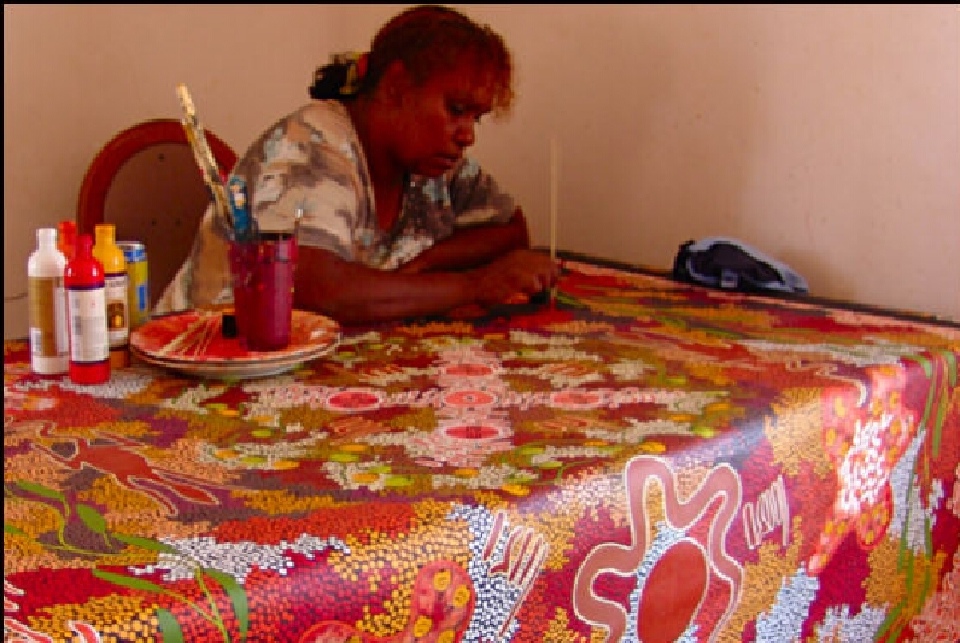Trephina Sultan Thanguwa

DOB:
1967
Born:
Alice Springs, NT
LANGUAGE GROUP: Luritja
Born in 1967 in Alice Springs, Trephina grew up with many uncles, aunties and cousins doting on her as a beautiful young Aboriginal girl, she was the only child in her family. Trephina's painting talents started at a very young age. As a young girl she used to sit and watch her uncles, aunties, cousins and friends paint for hours at a time. She would then pick up a stick and draw her art in the dirt.
With her mother and aunty a big influence in her life, Trephina went to the English speaking school at Alice Springs. Even though English became Trephina's first language, she was taught Luritja, the language of her family and Elders at home. Trephina, in her own words, had the best of both worlds.
The language skill she acquired stood Trephina in good stead. Acknowledged as a Luritja language specialist, she did work as an interpreter and in conjunction with colleagues and the Alice Springs Institute for Aboriginal Development, was a valuable contributor to an Aboriginal-English dictionary. However, Trephina's main love is painting. Her artwork drawing on the knowledge acquired in her youth, and the stories her family and Elders passed down.
For the Aboriginal people, the creation of art using the natural resources around them, dates back many thousands of years in Aboriginal culture. Art had revolved around symbolism and a limited set of colours, created by crushing ochres found in the region. Much of the early works were found depicted on rocks and in caves. The early 70s saw a change in the tools they used and a shift in style, with many Aboriginal artists expanding beyond the original colours of ochre, whilst using the modern medium of acrylic and canvas, interpreting their dream time and culture through the classic 'dot-style' that is synonymous with Aboriginal art movement.
Many of Trephina's early work is done in this 'dot-style'. Although she still produces artwork in this style, Trephina like many artists, has evolved from the natural colours reflected in the landscape of 'Central Australia' to expanding to a larger palate of colours. Other changes can also be seen in her work, as she tentatively paints in masterful strokes of vibrant hues, producing her very popular 'Tjanpi Kampanyi' (Burning Grass). These beautiful works are evocative and captures the very essence of Aboriginal culture: In casual conversation, it was interesting to hear from Trephina, how the style developed. She use to do it as a background and really liked the brush strokes on it's own. Even back then, it had evoked memories of burning grass. Now taking centre stage, each new 'Tjanpi Kampanyi' would burn in its own flames. With each canvas, Trephina would vary the colour, some showing black in the background, some white, others with bright orange-yellow flames. Even the size of the canvas would vary, from small two panel pieces, to larger two metre long paintings.
New works are emerging from her brush stokes, reflecting this abstract style, as can be seen in her recent 'Bush Onions' and 'Bush Honey'. With many more ideas filling her head, and the penchant for trying new ideas, we look forward to seeing Trephina's future works.
Trephina's paintings represent her family's culture, upbringing as a young child, and stories as told by her Elders. Her paintings include Aboriginal symbolism of vegetation, food sources, watering holes and the wildlife of Central Australia. Sometimes, she would wake up in the early morning with a memory resonating from her past. These may be a story or answer to some current piece she is working on, or the inspiration for a new painting.
Typical of many Aboriginal painters, Trephina before doing a new style of painting, would seek permission from her Elders. Some dreamtime stories are taboo, whilst other would still need the permission of the Elders.
Trephina's paintings have been bought by visitors to the Alice Springs area, over many years, and are displayed in houses all over Australia and the World. More recent works have been exhibited and sold in an exhibition in Melbourne.
Many of her works has been created under the name of Trephina Sultan, although she still continues to use this name on different works, some of her works will also bear her Aboriginal name of 'Thanguwa'. The equivalent meaning in English is 'scent'.
As a mother, Trephina has five children, 2 sons and 3 daughter, all of whom paint. Her young son Rueben Sultan is also following in his mother's footstep.
